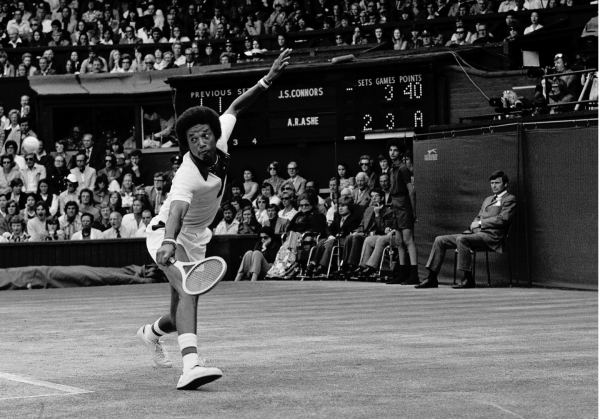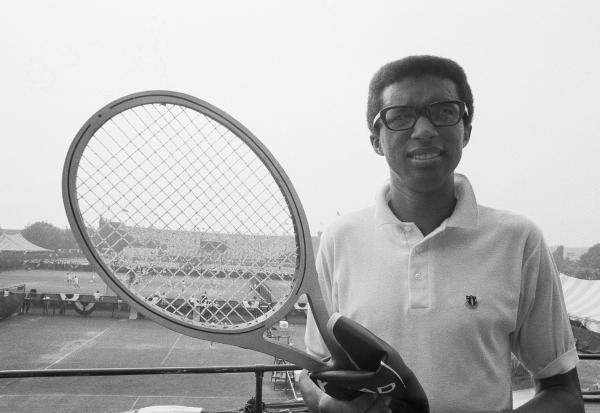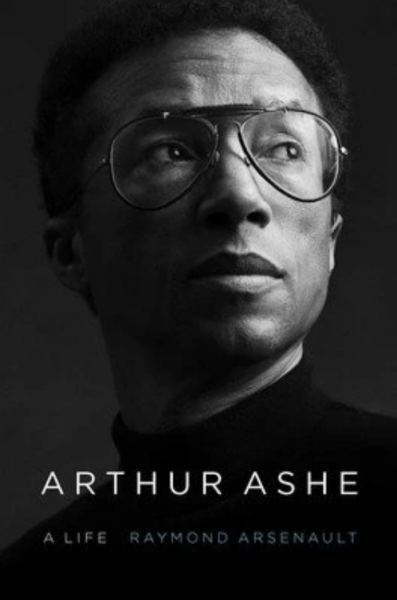
In 1975 Ashe became the first black player to win the men’s singles title at Wimbledon, beating Jimmy Connors in four sets. Associated Press
I met Arthur Ashe in the late 1970s, when I was 7 years old. He came to the little tennis club where I spent much of my childhood, Sportsmen’s Tennis Club in Dorchester, Mass., because he was a man who needed to do more than just hit the ball well; he needed to give back to the world, and one of the many ways he attempted to do that was by trying to inspire the next generation of black players. I don’t recall what Ashe said the day he stood in the clubhouse and gave a speech to 50 of us juniors as we sat on the floor by his feet, but I’ll never forget his regal bearing. His poise and dignity said so much about who he was and who we could become.
Ashe belongs on the Mount Rushmore of elite athletes who changed America — put him alongside Muhammad Ali, Jackie Robinson and Billie Jean King. Ashe’s journey from motherless child — she died during a pregnancy when he was 6 — to world-famous, Wimbledon-winning public intellectual, to a man dying of AIDS in 1993 at the age of 49, is detailed in an exhaustive new biography by the historian Raymond Arsenault called “Arthur Ashe: A Life.” For those who have long admired Ashe, this close look at his life offers even more evidence that he was more than a great player, he was an extraordinary person.
He began playing seriously in Virginia in the 1950s, molded primarily by the legendary coach Dr. Robert Johnson, who taught Ashe the same turn-the-other-cheek philosophy that Jackie Robinson used while breaking into baseball. “He preached subservience,” Johnson’s biographer wrote. He instructed his players “never to argue with the umpire, to pick up the balls and give them to the opponent when changing sides. He insisted that balls hit close to the line be called in favor of the opponent, even if the call is incorrect.” This, at a time when Emmett Till’s 1955 murder was fresh in the collective mind. His death inspired many to resist more forcefully, but many other blacks felt the safest course was to mollify whites. This strategy helped Ashe get into tournaments — and on the court he fought in a way that made it clear blacks could compete with whites.
To Dr. Johnson and others like him — including Jim Smith, who started my club, Sportsmen’s — tennis was part of a mission to prove blacks were equal with whites. To them, mastering tennis and playing it better than most white people would help destroy notions of inherent white superiority. But in order to get into tournaments at whites-only clubs, they had to behave impeccably. Thus Ashe became the paragon of what we now call respectability politics: He presented himself in a way meant to not make white people uncomfortable, no matter what.
He stuck with this strategy into early adulthood — in 1969, a year after he won the United States Open, he jumped onto a court at a whites-only club in Florida, and was ordered off a moment later by a man spewing a racial pejorative. Ashe may have had enough social power to challenge the man — he was in town to play in a nearby pro tournament where he was surely one of the top seeds — but he opted to leave quietly. This is a man who, in the late ’60s, said: “Sometimes a demonstration is the best way of getting headlines about a bad deal, but I don’t think demonstrators should try to make trouble for anyone. We’ll never advance very far by force, because we’re outnumbered 10 to 1. Quiet negotiation and slow infiltration look more hopeful to me. Does this make me an Uncle Tom? If so, O.K.”
Ashe was called an Uncle Tom throughout his life, but the term was undeserved. In the early ’70s he gained global stature as the world’s best-known black tennis player and realized that he must use his platform to help other black people. “He had both the opportunity and responsibility,” Arsenault writes, “to use his talent and position for a higher purpose than fame or personal gain.” And so the young man who was trained to never argue became outspoken about civil rights as an athlete-activist. He was most passionate about battling apartheid.

Harry Harris/Associated Press
Throughout the ’70s and ’80s Ashe worked to end the immoral policy of racial segregation in South Africa, a cause he gravitated to in part because it seemed less challenging for Americans to accept. “I was too confused about what was going on among the leaders of black America, especially the younger leaders, to know precisely where to tread,” Ashe once said. “South Africa was a clearer issue, and I turned to it almost with relief.” But he would find apartheid to be as complex as any American issue. He rejected the notion of boycotting South Africa and in 1973, after years of negotiation, played in the South African Open. His visit was a Rorschach. On the one hand, for many of the blacks who watched him from segregated stands, he was a liberated black man, which was thrilling for them to see. Mark Mathabane, who would grow up to write the acclaimed memoir “Kaffir Boy,” was there to see Ashe play, cheering from the segregated section. His mind was blown. Mathabane writes in his memoir, “How could a black man play such excellent tennis, move about the court with such self-confidence, trash a white man and be cheered by white people?” But for others Ashe’s historic visit only legitimized the South African government and helped it appear less racist. When he met with a group of black journalists, one man called him an Uncle Tom and another said, “Your presence delays our struggle.”
In 1980 Ashe retired after thriving in an era when on-court behavior was starting to get out of control, thanks to men like Ilie Nastase, Jimmy Connors and John McEnroe. Because of them, his reputation for sportsmanship and gentlemanly composure stood out. That reputation played a large part in his selection as America’s Davis Cup captain. He oversaw a team led by McEnroe, who was earning his Superbrat nickname and would send Ashe into one of the most turbulent moments of his career.
In 1981, in Cincinnati, the Americans were playing against a strong Argentine team when McEnroe — who’d already embarrassed Ashe in other matches — got into a war of words with the great José Luis Clerc and loudly cursed at him for all to hear. Ashe said: “I thought I might punch John. I have never punched anyone in my life, but I was truly on the brink of hitting him.” Yet the consummate sportsman went light on McEnroe, giving him just a stern warning. Some, at the time, felt Ashe had compromised his principles to placate his best player, but there was something deeper going on. The two men were opposites, but Ashe, who’d had it in him since childhood that he had to behave perfectly on the court, also had a sort of envy of McEnroe’s way. Later in life Ashe wrote: “Far from seeing John as an alien, I think I may have known him … as a reflection of an intimate part of myself. This sense of McEnroe as embodying feelings I could only repress, or as a kind of darker angel to my own tightly restrained spirit, may explain why I always hesitated to interfere with his rages even when he was excessive. … At some level … John was expressing my own rage, as I could never express it; and I perhaps was even grateful to him for doing so.” He also once remarked, “I’ve got to admit that for a long time I’ve had this urge to walk out on Centre Court at Wimbledon and for just one match act like McEnroe.” That said, he knew McEnroe would not have been able to act like that if he were black.
 “Arthur Ashe: A Life” is among the best books about tennis I’ve ever read — it’s a deep, detailed, thoughtful chronicle of one of the country’s best and most important players. I wanted to hear more, though, about Ashe’s game and what sort of player he was on the court. And the author (whose previous books include “Freedom Riders”) is on thin ice when he suggests that Ashe was more popular among whites than blacks. Among blacks who love tennis, Ashe remains a god to this day.
“Arthur Ashe: A Life” is among the best books about tennis I’ve ever read — it’s a deep, detailed, thoughtful chronicle of one of the country’s best and most important players. I wanted to hear more, though, about Ashe’s game and what sort of player he was on the court. And the author (whose previous books include “Freedom Riders”) is on thin ice when he suggests that Ashe was more popular among whites than blacks. Among blacks who love tennis, Ashe remains a god to this day.
It’s inspiring to read about Ashe growing up to become a political figure on his own terms, every bit as political as Ali, even as he employed the measured tones of a diplomat rather than the bombastic tones of a revolutionary. In many ways, Ashe, more than Ali, is the spiritual father of Colin Kaepernick, the seminal athlete-activist of today. Kaepernick’s protest — both his kneeling and his public persona over these last two years — has been calm and dignified in a way Ashe would have respected. Ashe is the kind of man we can hope our children grow up to be like — worldly, smart, cool, thoughtful, politically engaged — which is why my parents made sure I got to meet him all those years ago.
Touré is the host of the podcast “Touré Show” and a lifelong tennis player.
A version of this article appears in print on Sept. 2, 2018, on Page 9 of the Sunday Book Review with the headline: King Arthur’s Court.
